In the mid-1990s when carrot cake first appeared on my radar, when it finally emerged from its sandal-wearing exile and into the sugary lights of the mainstream, it seemed as absurd an idea as its contemporaries the pop tart and clear cola. Whatever would those Americans think of next, I wondered – and with cheese icing too! Ugh.
In fact, as Jane Grigson points out in English Food, our canny forebears were using carrots as a substitute for pricey imported dried fruits long before Ross and Rachel appeared on the scene – Mrs Beeton gives a recipe for a carrot pudding – while the Oxford Companion to Food suggests such dishes were particularly popular in the Middle Ages, when refined sugar was a rare and expensive commodity.
The idea enjoyed a revival thanks to wartime rationing, with the Ministry of Food, which was keen to shift the surplus of domestically-grown carrots, publishing leaflets encouraging housewives to try out carrot scramble, carrot charlotte and, yes, even a carrot cake, which, with a scanty 1½ tablespoons of sugar, dried egg, oatmeal and water, was probably not a version that would find its way on to the counter at Central Perk. No wonder we gladly forgot about it in the decades that followed.
In its sugary modern incarnation, however, and crowned with creamy icing, the healthiest thing about carrot cake is the name. But then that's probably why it's so darn popular.
The basics
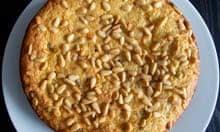
Not all carrot cakes are supersized, American-style. Nigella supplies a recipe originating from Venetian Jews which sounds refreshingly medieval, made as it is from ground almonds, rather than flour, enriched with eggs and olive oil and studded with booze-soaked sultanas and toasted pine nuts. As she admits, it's "not much to look at" – a golden disc about half the height of one layer of an ordinary cake – but it's incredibly moist and deliciously nutty, with a lovely citrus kick too. I love it, but I don't think it will chime with many people's idea of a perfect carrot cake, regretfully. (Given it's gluten and lactose-free, I suspect I may find myself making this one again for the digestively-challenged man in my life.)
Jane Grigson's recipe is also unusual: a fatless génoise reliant for volume on whisked egg whites rather than any raising agent. The whole mixture is as light as a cloud – even the carrots are finely shredded, rather than simply grated, and the flour is extra-fine – making for another very different carrot cake experience. The delicate sponge is a great showcase for the distinctive sweetness of the carrots, but it's overwhelmed by the heavy cream cheese icing – I think this would make a lovely fairy cake, or madeleine-style nibble, but it's too refined and subtle to qualify as a carrot cake.
Flours and fats
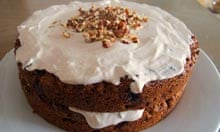
Back when it was the preserve of the Tom and Barbaras of this world, carrot cake was customarily made even more beardy with wholemeal flour, an approach still favoured by Claire Clark and Delia. I quite like the effect – although their cakes aren't as light as those made with white flour, it gives them a coarse, defiantly wholesome texture which works well with the strands of carrot. Like a good muesli, I think carrot cake should require a bit of effort in the dental department – a felicitous combination of afternoon tea and workout, so mine will be of the chewier variety.
To this end, I'm also going to use Geraldine Holt's light muscovado sugar, rather than the white sugar called for by most other recipes: Delia's dark muscovado is too aggressively treacly a flavour for my taste, but the slightly toffee-ish taste of the unrefined sugar is pleasingly raw. In her recipe, taken from the book Cakes originally published in 1980, Holt also flouts convention with melted butter, rather than the customary oil – butter, of course, was the enemy back then, but I love the rich flavour it gives her gorgeously fluffy cake.
Of fruit and spice
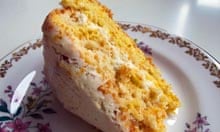
Carrots aren't the only good thing in this cake – it's often laden with fruit and nuts too, in the manner of a sugar-laden granola bar hoping to pass muster as a health food. Raisins or sultanas are popular – naughty Nigella soaks hers in rum first – Jane Grigson goes for hazelnuts, and pecans and coconut seem to feature in many American recipes and in Delia's cake, too. I find it an unlikely combination with carrot and, in my opinion, too dominant a flavour. If I'm going to go to the trouble of grating a carrot to put into a cake, I'd like to taste it. The sultanas are lovely though – although rum's always welcome, I don't think you need to soak them first with a moist cake like this – and I'm always a sucker for pecans. Having munched my way through six cakes, it's clear to me that my perfect version will be crammed full of such spuriously wholesome ingredients: they just feel right here.
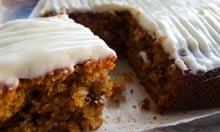
With the exception of Jane Grigson's minimalist take on the carrot cake, all the recipes I try are laden with sweet spice – cinnamon, nutmeg, mixed spice, even coriander in Geraldine Holt's daring recipe, which has me waxing nostalgic on the 1990s' trendiest soup variety.
I'm going to keep mine rather more low key, to retain as much carrot flavour as possible – a pinch of cinnamon, which I happen to think goes well with carrots in a savoury context too, and a little nutmeg should do it – and a little of Geraldine's orange zest too, in homage to that other tried and tested combination.
Nigella suggests draining the grated carrot in kitchen roll before using it, to absorb the excess liquid – but in a more conventional recipe, this doesn't seem necessary. Indeed, the extra water actually helps keep the cake pleasantly moist.
Icing
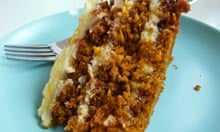
Carrot cake icing is one part of this delectable cake that I've never really warmed to – American tradition dictates a cream cheese "frosting", beaten with butter and sugar. Although I love buttercream as much as the next glutton, the cheese element is a step too far, adding a richness which tips the whole thing over into sickly territory, especially when, as with Claire Clark's recipe, there's three layers of the stuff to contend with.
If I thought the cheese and buttercream mixture OTT, the carrot cake at Philadelphia's much-mourned Commissary restaurant makes it look like positively understated. The recipe, which pops up again and again in online discussions of the perfect carrot cake, involves three layers of cake sandwiched with a decadent pecan caramel made from double cream, butter and sugar, and thickened with flour. The whole thing is then slathered with cream cheese frosting, and finally pebbledashed with toasted coconut. It's difficult to see the cake here as anything more than a structural necessity – there's more icing than sponge. The pecan filling is to die for, but it doesn't belong in a carrot cake – I'd happily scoop it out and eat it on its own.
It seems I'm not the only Briton to fail to see the appeal of cream cheese frosting. Nigel Slater suggests a rather bland mascarpone and cream cheese mixture, which is lighter, but doesn't quite set. Delia, meanwhile, drenches her ultimate carrot cake in a orange and lemon juice glaze before icing it with mascarpone and fromage frais. Although it works well on her cake, I think the glaze would make a moister version soggy, and the creamy icing isn't to my taste. As my recipe will be at the less sweet end of the spectrum, I'm going to go for the punchier version of the classic cream cheese topping recommended by Geraldine Holt, albeit without the butter and in strictly restrained quantities.
Perfect carrot cake

Helen Graves, author of the blog Food Stories, suggests adding a little orange zest to the icing, which lifts it (although, as I've got orange in the cake, I'm going to use lemon instead) as does using unrefined sugar to add a toffeeish note, but the most important thing, I think, to remember is that when applying, less is generally more. Because, if I say so myself, this is a cake that's good enough to eat on its own.
150g butter, melted, plus extra for greasing
150g soft light brown sugar
3 free-range eggs
200g self-raising wholemeal flour
1 tsp bicarbonate of soda
½ tsp salt
1 tsp ground cinnamon
½ tsp grated nutmeg
Zest of 1 orange
100g sultanas or raisins
200g carrots, peeled and grated
100g pecans, toasted and roughly chopped, plus extra to decorate
For the icing:
150g full-fat cream cheese
50g light brown soft sugar
Zest of ½ lemon and a squeeze of juice
1. Preheat the oven to 180C and grease and line the bases of 2 x 18cm sandwich tins.
2. Put the melted butter, sugar and eggs into a large mixing bowl and whisk well until the ingredients are thoroughly combined and the mixture has almost doubled in volume.
3. Sift together the flour, bicarb, salt and spices and then fold very gently into the liquid mixture, being careful to knock as little air out as possible. Fold in the remaining ingredients and divide between the tins. Bake for about 30 minutes until a skewer inserted into the middle comes out clean. Cool in the tins.
4. Meanwhile, beat together the icing ingredients and refrigerate. When the cakes are cool enough to ice, remove from the tins, top one with half the icing, and then the other cake. Ice the top, and decorate with the remaining pecans.
Is carrot cake really Britain's favourite cake, as a survey for Radio Time last year suggested, or just a passing fad from across the pond? What's your favourite recipe – American-style or otherwise – and which other vegetables can turn their hand to desserts?
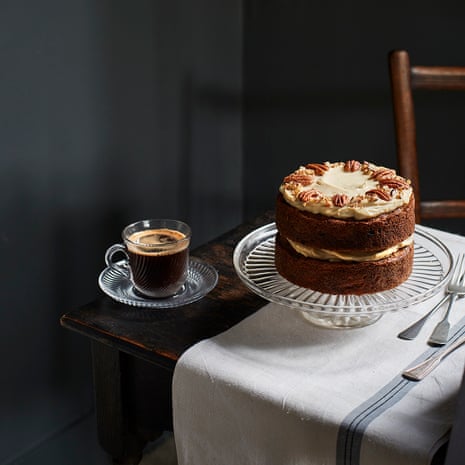
Comments (…)
Sign in or create your Guardian account to join the discussion